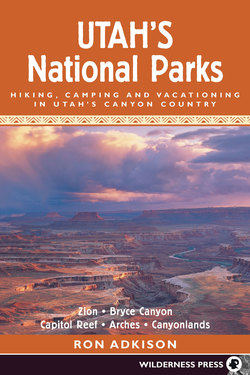Читать книгу Utah's National Parks - Ron Adkison - Страница 9
На сайте Литреса книга снята с продажи.
ОглавлениеUsing This Book
The Hike Descriptions
Here is a brief explanation of the hiking description format. A round-trip hike is one on which you retrace your outbound steps. A loop trip involves no retracing. A semiloop trip retraces part of a route after making a loop somewhere along the course. A shuttle trip is one in which hikers walk from one trailhead to another, requiring the use of two vehicles to establish a car shuttle or some other arrangement.
Low/High elevation figures give you an idea of how much you’ll climb and descend.
The “Suited for” classification tells whether a trip is a Walk (a short stroll accessible to anyone, even nonhikers), a Dayhike (usually a longer or more demanding trip lasting as long as all day), a Backpack (a trip on which you spend one or more nights in the backcountry), a 4WD Trip (usually accessible only to high-clearance 4WD vehicles), or a Mountain Bike Trip (a trip along a 4WD road accessible to mountain bikes). Some trips are “suited for” more than one of these.
The “difficulty” rating of a given hike is essentially arbitrary, arrived at by taking into account a variety of factors including length of the hike, elevation change, nature of the trail, and availability of water and shade—all in relation to the average hiker’s ability.
“Best Season” is the average optimum season in which to hike the trail, including those months with the greatest probability of fair weather and moderate temperatures. Seasons vary from year to year. In some years spring can be quite moist and cool, and in other years spring can be unusually hot and dry; likewise with the months of autumn. The parks, however, can be enjoyed year-around. Visitors are encouraged to check with the appropriate national park office to determine weather patterns prior to their visit.
“Hazards” indicate things the hiker should be aware of before venturing onto the trail. Only the most pertinent hazards are listed; all hikers are advised to be prepared for a variety of unexpected situations.
Mileage and elevation figures are given in parentheses within each hike description. The mileage figures are not cumulative, but rather give the distance from one point to the next. Elevation figures give the elevation at a particular point. The difference between two consecutive elevations does not necessarily indicate the amount of elevation gain or loss between the two points, as many trails have their ups and downs between points. Elevation figures were arrived at with the aid of topographic maps and an altimeter, and should be accurate within 20 feet.
The “Driving to the Trailheads” sections also list mileage figures, but not elevations. The first figure in parentheses is the mileage from the previous point; the second figure is the cumulative total from a given starting point.
Although this book is not a climber’s guide, some trips described herein may require that hikers have some rock-climbing ability.
Most trips described in this book follow trails or easy cross-country routes where the only skill required is walking—Class 1. Some cross-country routes may have sections or pitches that require scrambling or boulder-hopping—Class 2. Especially in narrow canyons, where dry waterfalls (pouroffs) or large boulders or chockstones block a route, a hiker must use relatively large hand- and footholds to surmount the obstruction—Class 3. Occasionally, these water-worn obstructions are smooth, sometimes with only minor handholds or small cracks. This type of climbing usually involves steep pitches and dangerous exposure—Class 4.
Butte and mesa
A quick look-up view on trips in this book.
Topographic Maps
The topographic maps in this book are parts of USGS quadrangles. The book’s maps are on a scale of 1:50,000, which equals 1.25 inches per mile. These maps, have been updated by the author, and they show the correct location of roads, trails, and park facilities.
The large numbers next to trails and 4WD trails on the book’s maps correspond to trip numbers described in the book. The small numbers are trailhead numbers, allowing hikers to quickly locate their trailhead.
The index map for each Utah national park shows the location and number of all the maps in the book for that park.
